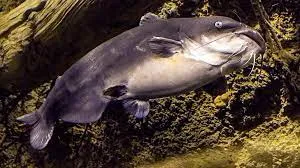
Catfish Chronicles: The Interesting Facts of the Murky Depths
We present some interesting facts about catfish. The murky depths of the freshwater world. A place of mystery, where sunlight struggles to penetrate and strange animals lurk in the shadows. Among these denizens of the deep dwell the catfish – often misunderstood, sometimes downright weird, but undeniably fascinating.

Forget your purring, cuddle-loving house cats – these guys are the whiskered warriors of the underwater world, cleaning crews extraordinaire, and living proof that nature has a twisted sense of humor (seriously, have you seen a catfish up close? Those barbels…). Grab your metaphorical flashlight (because let’s be honest, real flashlights probably won’t work down there) and get ready to dive into the fascinating, and occasionally fishy, world of catfish facts.

Fact #1: They’re Not All Bottom Feeders (Because Apparently Some Like a Fancy Meal)

The stereotype: catfish are bottom-dwelling scavengers, sifting through the muck for scraps and leftover sushi (hey, a hungry catfish doesn’t discriminate). The reality: catfish come in all shapes, sizes, and, most importantly, dietary preferences. While some species do indeed scour the riverbed for tasty morsels, others are active predators, equipped with sharp teeth and keen senses to hunt down unsuspecting prey.

There are even some catfish that are obligate piscivores, meaning they exclusively eat other fish (because apparently, even catfish have dietary restrictions). So, the next time you see a catfish, don’t assume it’s just there for the leftovers – it might be planning your fishy demise (okay, probably not, but you get the point).

Fact #2: They Have More Taste Buds Than You (And Probably Use Them for Way Weirder Things)

Catfish are the undisputed champions of taste. These whiskered wonders have taste buds all over their bodies – on their fins, their barbels (those whisker-like things), and even scattered across their skin. That’s right, they can basically taste their way through life (although, considering some of the things catfish eat, I’m not sure that’s a desirable superpower).

Scientists believe these taste buds help catfish navigate their murky environment, locate food sources, and maybe even communicate with each other (although, catfish conversations are probably not something you’d want to eavesdrop on). If you complain about the bland cafeteria food, just be thankful you don’t have to taste with your entire body (unless you’re into that kind of thing. No judgment here).

Fact #3: Some Can Breathe Air (Because Gills Just Weren’t Enough)

The catfish family tree is a tangled mess, filled with all sorts of evolutionary oddities. And one of the weirdest adaptations has to be the ability of some catfish species to breathe air. Yes, you read that right. These amphibious catfish have a special organ called an accessory air bladder that allows them to take in oxygen directly from the atmosphere.

Why? Well, because their natural habitats can sometimes become oxygen-depleted, and a resourceful catfish isn’t going to let a little thing like low oxygen levels stop it from finding dinner (or, you know, surviving). If you’re feeling suffocated by a crowded subway car, just be thankful you’re not a catfish who has to breathe air to survive (although, sometimes the subway can feel pretty darn suffocating).
Fact #4: They’re the Ultimate Clean-Up Crew (Because Someone’s Gotta Do the Dirty Work)

Let’s face it, the bottom of a freshwater ecosystem isn’t exactly the most glamorous place. It’s a mucky mess of decaying leaves, leftover fish food, and other unmentionable things. But fear not, because catfish are here to save the day (or, you know, the lake)! These bottom feeders act as nature’s janitorial staff, constantly sifting through the muck and consuming organic debris.

They’re like the underwater vacuum cleaners, keeping the ecosystem clean and healthy (even if they do look a little creepy while doing it). If you see a catfish, give it a silent thank you for its contribution to a cleaner, less-smelly underwater world.
Fact #5: They Can Use Electricity (Because Why Not? Nature is Wild)

If you thought catfish were weird enough already, buckle up. Some catfish species, like the aptly named electric catfish, have the ability to generate electricity. They use these electrical pulses for a variety of purposes, including navigation, communication, and, of course, stunning their prey. Imagine swimming along minding your own business when suddenly you get zapped by a catfish – not exactly the most relaxing way to spend an afternoon.

If you’re considering getting a catfish for your home aquarium, think twice. Sure, they might be fascinating animals, but a surprise electric shock isn’t exactly the best way to liven up your living room décor (unless you’re into that kind of excitement. Again, no judgment here, but maybe invest in some rubber gloves first).
Conclusion

Catfish have long intertwined with human cultures across the globe. They are a valuable food source, prized for their flavor and versatility in various cuisines. For some, they are even cherished aquarium fish, adding a touch of the exotic to our homes. The presence of catfish in myths and legends speaks to the human fascination with these unusual animals. As we continue to learn more about catfish behavior and communication, these remarkable fish promise to hold our interest for generations to come. Whether gracing our plates, our tanks, or our stories, catfish remain an intriguing and significant part of our world.
Leave a Reply